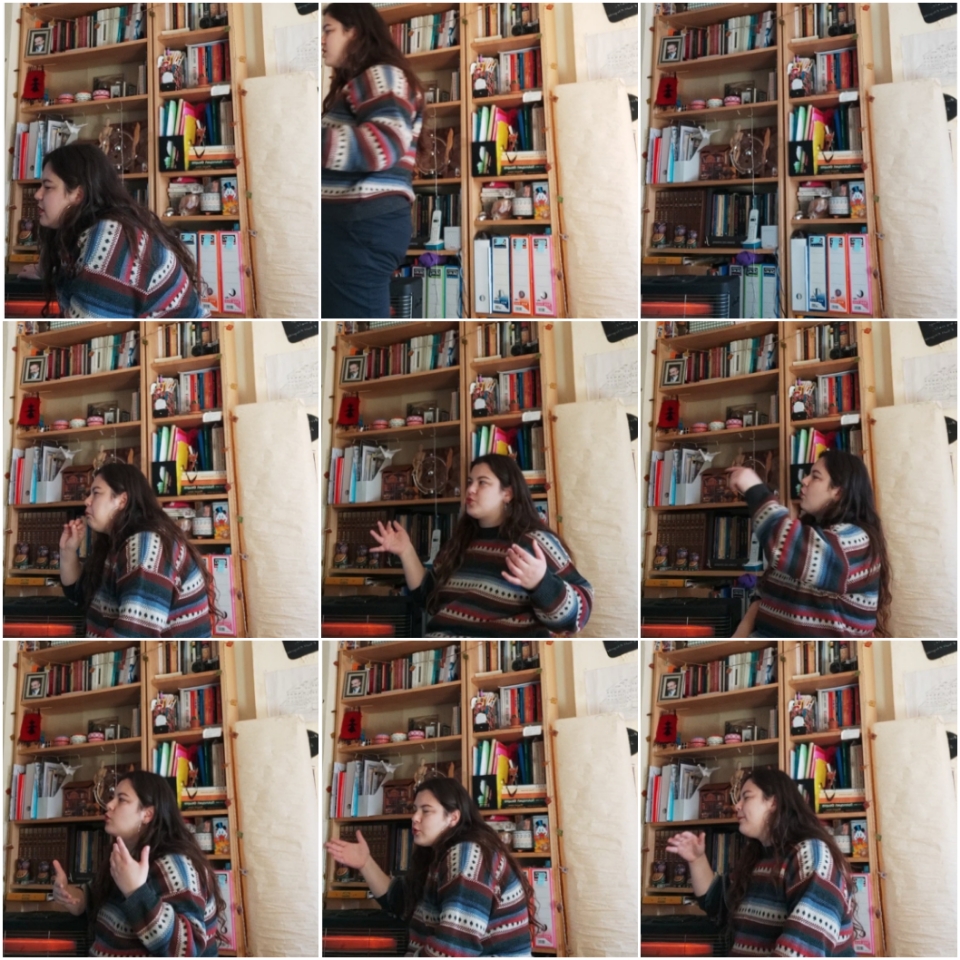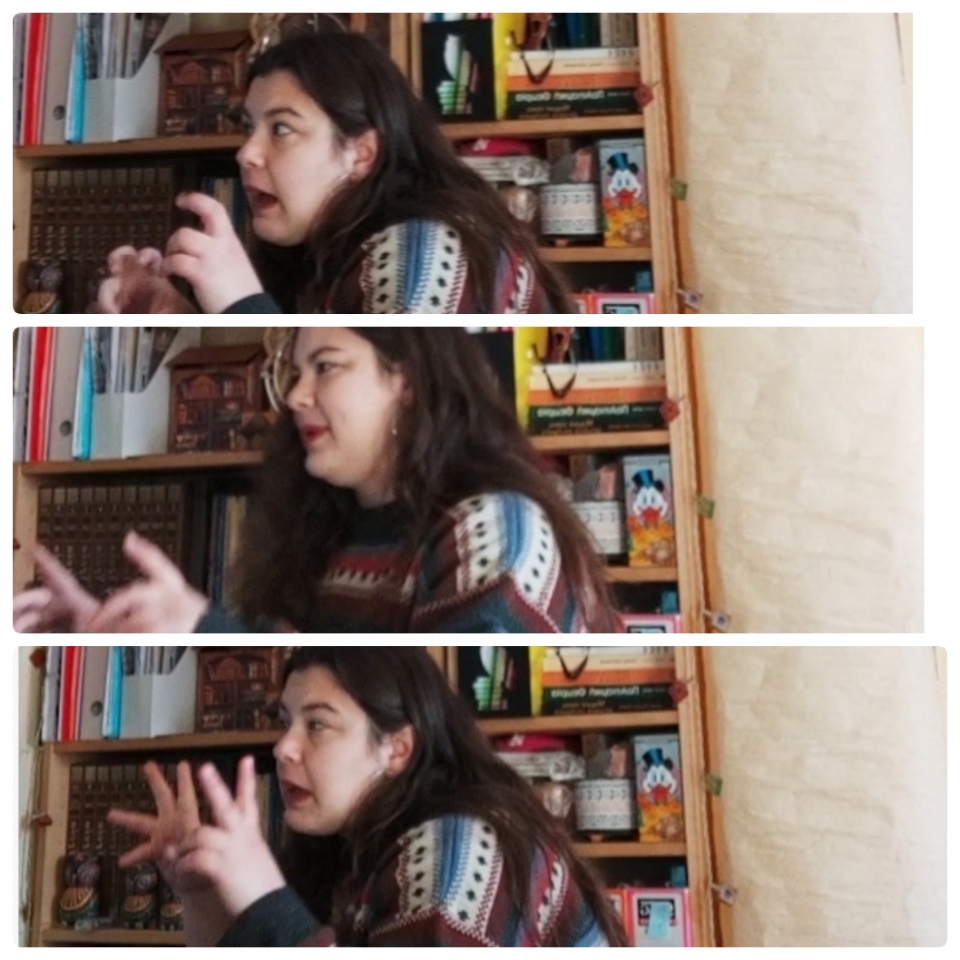
The initial observation from which the project emerged was the new role that voice gained in the context of remote learning where. Due to the cameras usually being off, the voice had to fully represent the person’s presence. Based on that, I start thinking that one’s substance/presence is divided into three parts: first, their voice, second, their image and third, – Something which the new conditions of online meetings made me realize did not coincide with the second one (the image) -, the live presence.
The main intention is to understand how these three elements/tools of communication –as I defined them above-interact with each other. What happens when not all of them can be present simultaneously in order to act together for the best encounter possible ? How do their relationships and interdependencies evolve into a dynamic connection? Calls, video calls and in-person discussions constitute a promising field to answer these questions. One of the methods I put in practice is observing and recording myself during these different types of encounters. I also tried to produce the same message in its different stages based on the three basic elements (voice, sound, presence). Starting with the form that has none of the three, up to the stage that has it all. Carrying out some sort of sensory ethnography with myself I seek to be more conscious of the processes of hearing-speaking, seeing- showing and feeling during the conversations.
Through these observations one can approach the ways in which we use our senses to achieve the best possible communication, especially during the fragmented encounters of calls and video calls. There is a shift in the meaning, the importance, the ranking of the senses when a threefold individual loses one or several of his/her communication tools. I observe myself: in which cases do I feel uncomfortable, when do I feel easier understood, which element of my communication would I prefer to be distorted?
By the end of the project I hope to learn more in regard to the following ideas:
-The correlation between the voice, image and the live presence when one of them is absent or distorted.
-How communication between two people through digital media is constructed and what does it depend on.
-How is this momentary encounter shaped in terms of the relationship between hearing, image and feeling.

Gefsi.
Nice project and description. And images! Did you use an extra camera to record yourself from the side during online classes?
I’m looking forward to seeing how you will proceed with this – hope you will stay both with the sensory and the analytical side of your autoethnography. I think you capture what a lot of us (teachers, students, people meeting online whether we like it or not) experience. While I am teaching I feel obliged to keep my camera on, but I think your 3-part analysis makes sense. And; after the initial complaints from teachers about students being ‘dark screens’, we have started experiencing – and perhaps enacting? – ‘live presence’ in more nuanced ways. Also, I actually feel I have experienced quite a lot of intimacy with people (students, colleagues) online, such as people crying or sharing private concerns. Or maybe it just becomes more apparent on a screen than it would in a regular conversation?
Thank you for the comments!
For now, I am not recording myself in the “classroom” but maybe I will do it in the future. If I do, I will use an extra camera in order to record my whole body. I am currently trying to produce the same message in the three different forms it might take based on the three-part distinction (through phone call, video call and in person communication). I believe that having a similar/relevant context, the difference (if I find one) would me more evident. Maybe I will combine both of the methods above..
What becomes more apparent on a screen and what remains hidden (unaffectedly or strategically) is really at the core of my concerns. I am thinking about feelings that would have been salient in an in-person encounter but remain silent in zoom. I am also thinking about gestures, nods, motions that gain a new meaning during an online meeting, the suddenly become more serious and important. I mean… how can we be sure what the other person is feeling, doing, thinking while we see only ¼ of his/her body, we can’t feel their aura, we see their eyes but not into their eyes. [I hope to work on it during this, or any future project.]
The same applies to the very practical things people do or don’t do during a meeting. Yesterday, being really focused on what the teacher was saying in the class and having my camera on, I was chopping some mushrooms on my table/desk which wasn’t seen on the camera. In the last year, the class has entered my house, my bedroom and my kitchen. It was a matter of time for the kitchen to enter my class.
Curious to see the experiment and the video! I love the idea of the world becoming aware of the mediation processes that allow us to communicate due to the pandemic. The importance of voice is something Panos has been working on, and I have written an essay on ‘voice’ in Dutch, which I might throw in google translate for you to get an idea of the argument – which is that when I deliver my thoughts in spoken words – rather than written ones — all kinds of extra information about myself enters into the communication, an immediating un-doing of the abstraction writing allows: this is not ‘an author’ articulating his thoughts, but ‘an older male, speaking English with an accent, slightly nervous, recovering from sinusitis, etc etc etc’. In the light of discussion on positionalily — the rejection of academic ideal to be “the voice from nowhere” — we should all go back to speaking.
The other thing that struck me is the overlap with the Amsterdam team project, which has indeed tried to dissect a video-fragement by silencing sound, or invisibilizing images, so as to attune to the encounter differently.